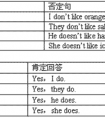句型转换。1. That is a cat. (改为复数形式)_________________________________2. There is some water in the cup. (改为疑问句形式)3. He likes going swimming. (-六年级英语
他/她/它们
考点名称:指示代词
指示代词:
是表示指示概念的代词,即用来指示或标识人或事物的代词。
指示代词与定冠词和人称代词一样,都具有指定的含义,用来起指示作用,或用来代替前面已提到过的名词。
指示代词分单数(this/that)和复数(these/those)两种形式,既可作限定词又可做代词,
例如:单数复数
限定词:This girl is Mary.Those men are my teachers.
代词:This is Mary. Those are my teachers.指示代词用法:
1、this和these指在时间或空间上较近的人或者事物,that和those指在时间或空间上较远的人或者事物。如:
This is a pen and that’s an eraser. 这是一支笔,那是块橡皮擦。
This is a boy and those are girls. 这是个男孩,那些是女孩。
2、指示代词所指的对象取决于说话者和听话者共同熟悉的语境。如:
I liked this movie today better than that concert last night.
我喜欢今天的这个电影,胜过昨晚的那个音乐会。
3、指示代词具有名词和形容词性质,既可指人也可指物。但是在相当于名词时一般指物多于指人。如:
I found this wallet. I found this.我找到了这只皮夹子。我找到了这个。(this 等于 this wallet)
Is she going to marry that man?她打算跟那人结婚吗?(that man不得用that代替,否则有轻蔑之意)
4、相当于名词的指示代词在句中作主语时,则指物指人均可。如:
What are these? 那些是什么?(指物)
This is Bill. Is that George? 我是比尔。你是乔治吗?(电话用语)(指人)
5、打电话过程中,介绍自己时通常用this指代“我”,不用代词I;询问对方时用that指代“你”,不用代词you。如:
Hello. This is Mary. Who’s that? 喂,我是玛丽。你是谁?
This is Tom. 我是汤姆。
6、当指示代词所指的事物已确定时,后面的指示代词则用it或they代替。如:
This (suit) is expensive, isn't it? 这套衣服昂贵,不是吗?
"Are those yours?" "Yes, they are." “那些是你的吗?”“是的,它们是我的。”
考点名称:规则形容词的比较级
- 当我们需要对事物作出比较时,需要用到比较级。
比较级的句子结构通常是:
什么 + 动词be (am , is , are ) + 形容词比较级 + than(比)+ 什么 ,意为:“比……更……”。 如:
I’m taller and heavier than you. (我比你更高和更重。)
An elephant is bigger than a tiger. (一只大象比一只老虎更大。) - 形容词的比较级变化规则:
形容词的比较级是在形容词的基础上变化而来的,规则形容词的比较级变化规则是:
① 一般的直接在词尾加er ,如 tall - taller , strong - stronger ,
② 以e结尾的,直接加r ,如 fine – finer ,
③ 以辅音字母加y结尾的,先改y为i再加er,如funny - funnier
④ 双写最后的字母再加er,如big – bigger, thin – thinner ,
hot – hotter
下表举例列举一些形容词的原级和比较级。
原级 比较级 long longer large larger dry drier big bigger hot hotter
考点名称:疑问副词
- 疑问副词:
用来引导特殊疑问句,表示时间,地点,方式,原因等,常见的有:when,where,how,why等。
分类:
时间副词:now, then, yesterday, always, already, soon
地点副词:here, home, upstairs, nowhere, above, near, beyond
方式副词:多数是形容词加上ly构成的,和一些well, fast, quick, slow, hard, alone, straight, wide
在加词尾ly时要注意:
(1)辅音+le:simple→simply, gentle→gently,
(2)以ic结尾的词:classic→classical但是public→publicly
(3)以辅音读音是[i]的y结尾的词:easy→easily
(4)特例:full→fully, whole→wholly, true→truly
程度副词,连接副词,关系副词
much, enough, quite, hardly, almost, deeply
疑问副词连接副词,关系副词:
how,who,where - 疑问副词在句中的位置及用法举例:
由于疑问副词后接疑问句,因此这些副词一般都位于句首。例如:
How do you go to school? 你怎么去上学?
Why do you dislike the game? 为什么你不喜欢这个游戏? - 疑问代词和疑问副词区别:
1. 疑问代词做对陈述句的主语,宾语或定语提问,即做句子的主语,宾语或定语, 如:
what, who/ whom, whose.
eg. Who is talking ?
What can you see?
Whose shirt is this?
2.疑问副词对时间,地点,方式等状语提问,如:
when, where, how 等.
eg. When is your birthday?
Where are you going?
How do you know?
- 最新内容
- 相关内容
- 网友推荐
- 图文推荐
| [家长教育] 孩子为什么会和父母感情疏离? (2019-07-14) |
| [教师分享] 给远方姐姐的一封信 (2018-11-07) |
| [教师分享] 伸缩门 (2018-11-07) |
| [教师分享] 回家乡 (2018-11-07) |
| [教师分享] 是风味也是人间 (2018-11-07) |
| [教师分享] 一句格言的启示 (2018-11-07) |
| [教师分享] 无规矩不成方圆 (2018-11-07) |
| [教师分享] 第十届全国教育名家论坛有感(二) (2018-11-07) |
| [教师分享] 贪玩的小狗 (2018-11-07) |
| [教师分享] 未命名文章 (2018-11-07) |


![nice dinner![ ]A. WhatB. HowC. What a-四年级英语](http://www.00-edu.com/d/file/ks/4/1/69/2019-09-08/smalleb39374246af3637d7bd860a80eff1591567884271.jpg)
